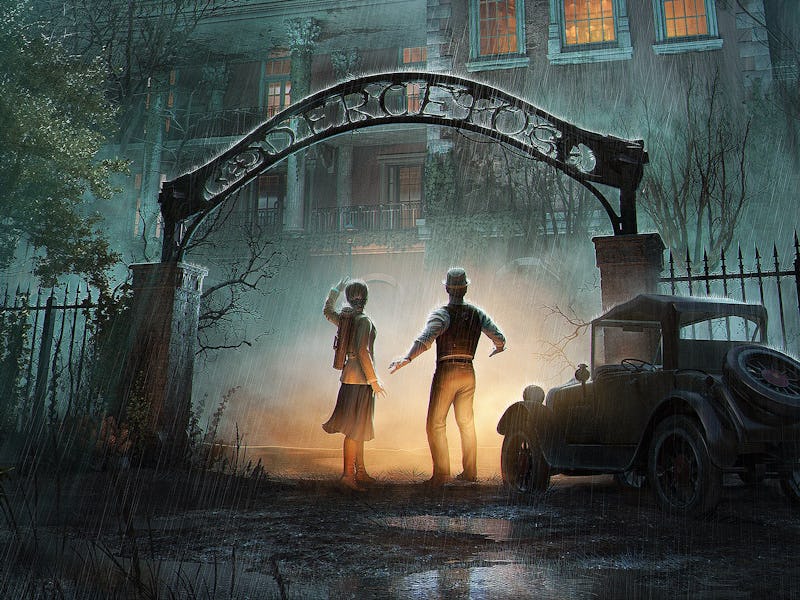Alone In The Dark Is the Best and Worst of Survival Horror, All at Once
A lackluster comeback.

The original Alone in the Dark is often credited as the game that created the survival horror genre. Despite that massive influence, the early ‘90s franchise never capitalized on the ideas it established, allowing later games like Resident Evil and Silent Hill to dominate the genre instead. Three decades later, the new Alone in the Dark hopes to bring the series back from the dead, but much like the creatures you face, it’s a game that often feels like a soulless husk. Glimmers of what the Alone in the Dark does well (like its phenomenal aesthetic) get buried under an avalanche of questionable design and story choices. Ultimately, this 2024 reimagining of a video game classic somehow manages to embrace both the best and worst elements of survival horror, all at once.
Derceto is a fantastic setting aesthetically, a grungy 1920 manor filled with lavish details.
Like the original, Alone in the Dark (2024) is set in 1920s Louisiana. While many of the characters and locations are the same, the narrative is largely a new experience that builds off familiar elements. You follow two playable protagonists: private investigator Edward Carnby (voiced by David Harbour), and his client Emily Hartwood (Jodie Comer). The pair have traveled to a psychiatric hospital called Derceto Manor in search of Hartwood’s uncle Jeremy after he sent her a cryptic letter. At the beginning of the game you choose which character to play as, and as the narrative plays out the same, Emily and Carnby have different dialogue and perspectives on the story. This means if you want to see the full picture, you’ll need to play through from each perspective.
The initial hours are where Alone in the Dark’s strengths really shine through, as Derceto Manor is a marvelously realized location that genuinely oozes atmosphere. It’s a self-contained setting packed to the brim with puzzles, bizarre residents, and bits of lore to uncover. Sections where you explore the manor are some of the best the game has to offer. It feels incredibly reminiscent of Spencer Mansion from Resident Evil, in a good way.
Alone in the Dark’s dual protagonists mean you need to play the game twice to get the full story.
Unfortunately, everything else outside Spencer Mansion is where Alone in the Dark stumbles, and often falls. Interspersed among exploring Derceto are sections where your character gets transported to a dreamlike world created from Jeremy’s tortured psyche. These sections are often aesthetically pleasing, but force you into obtuse puzzles and abysmal combat.
Combat was never going to be the focus of an Alone in the Dark game, but every enemy encounter here feels like an absolute slog. The shooting and melee mechanics are stiff and unwieldy, the same enemy types are repeated across the game, and I often found myself getting stuck on objects in the environment, forcing me to reload. These issues are only compounded further by some truly baffling boss encounters later in the game. Along those same lines, many of Alone in the Dark’s puzzles (outside of Derceto) feel far too obtuse with one-off solutions that don’t stick to ideas or mechanics that were established earlier.
Alone in the Dark’s storytelling often feels confusing and convoluted, but also fails to meaningfully talk about the heavy themes at its core.
Alone in the Dark’s storytelling feels equally messy. The story weaves together elements of psychological and Lovecraftian horror, but doubles down on using mental health as a driving narrative force. Unfortunately, it’s executed incredibly poorly. It’s hard to talk about this in detail without spoiling anything, but there’s a resolution for how Jeremy’s “mental illness” is solved that completely misses the mark. While most of the game’s horror is built on the idea of mental illness and how that can alter reality, Alone in the Dark utterly fails to say anything meaningful on the subject or use mental illness in any way outside of a plot device. Survival horror games misusing mental illness isn’t something new, but there are games out there that have found ways to integrate the topic with care, like Silent Hill 2 or The Evil Within.
This is made all the more disappointing because of the acting talent attached to the game. Harbour and Comer give solid performances here, but both characters largely feel disconnected from the plot outside of being physically present in events. The talented actors could have flourished with more thematic material that put their characters front and center.
Alone in the Dark is the kind of game I don’t necessarily regret playing, but for every little thing I loved, there were three things I hated. The aesthetic and environmental design are genuinely great, featuring eerie locations that really evoke the 1920s setting in imaginative ways, and the best mansion since Resident Evil. But making your way through those environments is filled with so much frustration, compounded by the fact that the two playable characters retread the same ground. And the story can feel downright incomprehensible at times, highlighted by a lack of care for its more sensitive material. If Alone in the Dark was ever going to have a comeback, this is far from what the series needed.